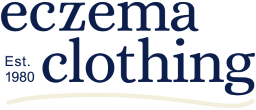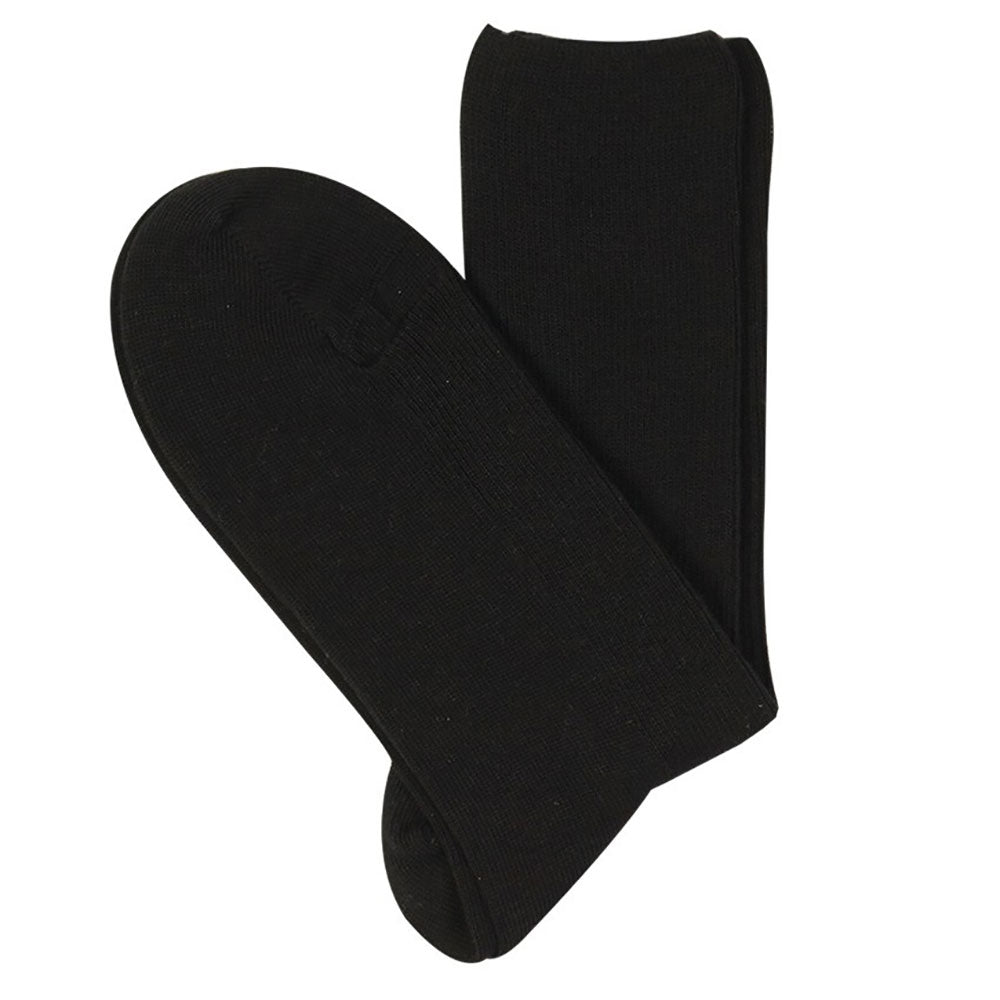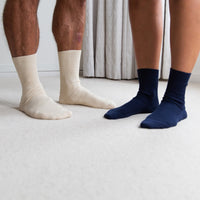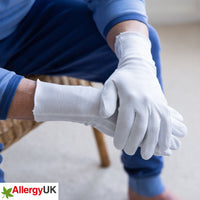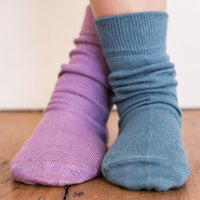why cotton comfort?

Our clothing has been endorsed by experts and we have bags of post and emails from grateful customers (see testimonials for a few examples).
Why is this?
certified organic cotton
Where possible we use GOTS Certified (not just claimed) organic cotton which means no pesticide residues, chemical finishes or bleached white fabric. This ensures our clothing is free of toxins and our fabric is as soft as possible.
100% cotton that really is 100% - we do not use the (legal) allowance that would allow us to add 2-4% other fibres to the mix. Little known but allowed by law to account for 'trimmings' however these extra % are frequently used to maximize profits by less honest producers.
No extra 'remedy' coatings added to the fabric, leaving your regular emollients or medication to be applied as, when and where it is needed and not have to compete with other products with unknown combined effects.
washable at 60 degrees or above
This is essential to eliminate house dust mite allergen and to remove residues of oil/cream and dead skin build up from the inside of clothing.
attention to detail

Our eczema nightwear has flat seams inside and out for extra comfort (so they cannot be used to scratch against). Many other products have no seams on the body at all.
Our clothing has soft ribbed edges and covered non latex elastic There are 'easy remove' labels on the outside of all Cotton Comfort own brand clothing.
We insist on top quality to withstand the extra wear, tear and frequent washing essential for eczema sufferers.
Colours are as natural as possible with no azo dyes. The chemical dyes that belong to a group called azo dyes are the most allergenic. These dyes are water soluble; sweat can have the same effect, which leads to the dye coming in direct contact with the skin and increasing the risk of developing an allergy.
formaldehyde free clothing
All Cotton Comfort clothing is free of this highly toxic product that has been classified as a human carcinogenic by The International Agency for research on Cancer (IARC).
It is used in the production of glues, adhesives and occurs in some household products and non organic clothing.
latex free products
Here at Cotton Comfort we are aware of the long term effects that exposing babies and children to natural rubber latex (NRL) can have on their health and well being and endeavour to ensure all our products are Latex free.
NRL is an integral part of thousands of everyday consumer and healthcare items.
what is organic cotton?

Organic cotton is grown without using pesticides from plants which are not genetically modified.
High levels of agrochemicals are used in the production of non-organic, conventional cotton.
Conventional cotton production uses more chemicals per unit area than any other crop and accounts for a total of around 25% of the world's pesticides. The chemicals used in the processing of conventional cotton also pollute the air and surface waters. Residual chemicals may also irritate skin.
Organic cotton is grown using methods and materials that have a low impact on the environment. The organic production system replenishes and maintains soil fertility, reduces the use of toxic and persistent pesticides and fertilizers, and builds biologically diverse agriculture. Third-party certification organizations verify that organic producers use only methods and materials allowed in organic production. Organic agriculture uses crop rotation instead of agrochemicals along with artificial fertilizers and biological pest control instead of pesticides. Though organic cotton has less environmental impact than conventional cotton, it costs more to produce. Cotton sold as organic must be grown according to the international guidelines for organic crop production.
Soil fertility practices that meet organic certification standards typically include crop rotation, cover cropping, animal manure additions, and use of naturally occurring rock powders. Weed management is accomplished by a combination of cultivation, flame weeding, and other cultural practices.
what are the benefits of organic cotton for you and your children?

People with allergies and chemical sensitivity especially benefit from organic cotton clothing, as conventional cotton may retain harmful toxic residues. Even if you don't have sensitive skin, organic cotton will just feel better against your skin.
Children are at greater risk for pesticide-related health problems than adults. Millions of children in the US receive up to 35% off their estimated lifetime dose of some carcinogenic pesticides by age five through food, contaminated drinking water, household use, and pesticide drift.
The majority of well known high street stores and supermarkets are selling conventional cotton with toxic finishes and residues of pesticides (unless the fabric has an Organic certification) with all the negative health implications for us and our children. Young children are especially vulnerable to the harmful effects of pesticides, and we know that exposure has been linked to the development of ADHD
Organic clothing can help reduce exposure to allergens and other irritants and is more comfortable to wear.
negatives of conventional cotton production for the cotton workers and the environment

Crops that are grown using organic methods means a lot to the environment, as well as to all the hands that actually work with and among the plants. Cotton that is not grown organically is treated with pesticides, herbicides, and chemical fertilizers. Harvesting organic cotton is much safer for the workers who pick it, and those living near cotton crops won't have pesticides in their water sources, enabling them to grow food for their families and animals. Plus, the producers can't use GMO crops.
Farmworkers working in conventionally grown cotton fields around the world suffer from an abundance of toxic exposures and related health problems. Pesticides used on cotton cause acute poisonings and chronic illness to farm workers worldwide. Acute respiratory symptoms and other health effects in communities surrounding cotton farms are correlated with high use of chemicals.
toxins used in non organic fabric treatment

Most clothing is produced with synthetic dyes and is treated with toxic chemicals to provide wrinkle resistance, stain resistance, fade resistance, static cling resistance, etc. In fact, that 'new' smell in clothing usually indicates chemicals - and if the smell lingers after a washing, the chemicals haven't been banished.
Here's some of the bad stuff found in some conventional fabrics:
Benzidine-based “azo dyes” are synthetic colourants, some of which may release carcinogenic amines (ammonia derivatives)
Certain azo dyes have been recognized as human bladder carcinogens and are also detrimental to the environment.
In particular, o-dianisidine is a classified as potentially cancer causing in humans.
Formaldehyde is a known carcinogen ( see Formaldehyde info box)
Perfluorochemicals (PFCs) are a group of chemicals that work to repel water and stains, in particular grease.
According to EWG (Environmental Working Group), PCFs break down into a toxic blood contaminant called PFOA (perfluorooctanoic acid), and they are ubiquitous (over 90% of Americans are shown to have PFOA in their bloodstream). PCFs are found in cosmetics, household cleaners, packaged food containers, microwave popcorn, furniture, paper plates, and nonstick pans, amongst other places. In clothing, PFCs are usually lurking in wrinkle-, water-, and stain-resistant clothing, including those with Scotchgard and Gore-Tex tags.
Nonylphenol ethoxylate (NPEs) are cheap surfactants sometimes used in the textile industry. They also act as hormone disruptors that end up in our water supply when we launder clothing that contains them.
Phthalates Children are at a significantly higher risk than adults when it comes to phthalate exposure, and phthalates are often found in clothing dyes and in plastisol prints.
can organic clothing contain these chemicals?
Since 2011 all textiles (including mattresses) labelled as 'organic' must have a third party certification, ideally GOTS, which ensures that the entire production process is gentle on the environment and the person wearing the garment
what is formaldehyde and why is it used in clothing and household products?

All Cotton Comfort clothing is free of this highly toxic product that has been classified as a human carcinogenic by The International Agency for research on Cancer (IARC)
Formaldehyde (yes – the same substance used to preserve corpses!) is a highly toxic colourless, corrosive, flammable gas with a pungent suffocating odour linked to skin problems, dermatitis, eczema and allergic reactions
It is mainly used in the production of industrial materials such as plywood and fibreboard, glues and adhesives, paper product coatings and certain insulation materials as well as being used for embalming bodies.
It occurs in some household products, beauty products and non organic clothing.
Formaldehyde is also released in car emissions, smoke from wood fires and tobacco smoke.
profit
Formaldehyde is used as a coating on fabrics, a chemical dip to give them a finish that can then be sold as 'non-iron' 'anti crease' 'easy care' 'stain resistant''anti cling' anti static' 'anti wrinkle' 'anti-shrink'
It is also used to make clothing waterproof, mildew resistant and colour fast.
Many suppliers and clothing chains in the UK use formaldehyde to prevent mildew and creasing (more can be packed into the containers) during shipping from China, Bangladesh etc. This can be hugely cost saving for wholesalers and retailers with devastating effects on our health.
Small quantities can be found in cleaning products as well as lotions, shampoo, sunblock, soap bars, cosmetics, body wash, toothpaste, baby wipes and bubble bath.
Only Sweden and Japan ban formaldehyde from cosmetics and toiletries.
Check labels on products like baby bath & shampoos for these common formaldehyde-releasing agents:
DMDM hydantoin
Diazolidinyl urea
Imidazolidinyl urea
Quaternium-15
what impact does formaldehyde have on eczema and other allergies?

Frequent or prolonged exposure to formaldehyde in products and clothing can cause hypersensitivity, leading to the development of allergic contact dermatitis. Sweat or sebum appears to leach free formaldehyde from formaldehyde resins.
Tests have shown that even after washing the fabric there was no significant reduction in the degree of formaldehyde found in the clothing – it cannot be washed out.
Formaldehyde gas is released with heat so be aware that nightwear and bedding will respond to body heat and give off gas overnight having an adverse effect on anyone prone to asthma or chest problems as well as affecting areas of eczema.
how do I know if my clothing contains formaldehyde and how do I avoid it?
Alarmingly there is no regulation in the UK to control the chemical finishes, formaldehyde and azo dyes used on our clothing on imported goods and no known research into chemical use in clothing in the UK since 2007.
Clothing produced in the UK is subject to some controls as the European Union limits formaldehyde residues in children's clothes to a maximum of 30ppm
International research supported by the World Health Organisation shows exposure to formaldehyde in concentrations of 20 parts per million (ppm) can cause eye, skin and nasal irritations, respiratory problems, asthma and cancer
Tests in New Zealand on cotton baby clothes imported from China found formaldehyde levels at a shocking 500 times higher than the safety limit.
Chemical finishes are not required to be declared on the label.
Choosing Certified Organic Cotton is the only safe way to ensure that unregulated toxins are not having an adverse effect on you and your family
We are what we wear
cotton comfort top tips
1. Buy clothing made from Certified organic Cotton
2. Avoid all chemical finishes and easy care clothing
3. Always buy Organic household and care products
what is latex / nrl?

Natural rubber latex (NRL) is a milky fluid obtained from the Hevea brasiliensis tree, which is widely grown in South East Asia, and other countries. NRL is an integral part of thousands of everyday consumer and healthcare items
latex awareness
Be aware that Latex sensitivity can develop with long term exposure to latex proteins which can trigger an allergic reaction in people prone to allergies and eczema. Here at Cotton Comfort we are aware of the long term effects that exposing babies and children to NRL can have on their health and well being and endeavour to ensure all our products are Latex free.
what causes a latex allergy?

The proteins naturally present in natural rubber latex cause the allergies either through direct contact with the skin or by inhalation of the powder Sensitivity can develop through long term or early exposure. If you have a predisposition to allergies and eczema in your family we would urge you to consider non exposure to Latex products for your babies and children.
what are the symptoms?
Most of the associated problems are skin related – hives, blisters, itching and eczema as well as nasal congestion and itchy eyes, nose and throat. Some sufferers also experience symptoms ranging from mild breathing difficulties to more severe reactions such as asthma and potentially anaphylaxis shock, although this is less common.
why is latex in so many every day items including clothing and food?

Latex is more economical and easier to use in sewing than synthetic elastics. NRL yarns are commonly used in surgical gloves and fabrics, elastic bandages, underwear, socks and hosiery, raincoats, shoe fabrics, wellington boots and running shoes as well as rubber bands and party balloons. Cuffs and waistbands on clothing are a common problem.
Organic mattresses made from coir (a natural fibre extracted from the husk of coconuts) generally use latex to glue the coir fibres together, causing issues for children and adults who can or have become sensitive to it. This is commonly found in ‘Organic’ or 'Natural' baby mattresses.
latex in food
Cross-reactions may occur between the residual parts of plant proteins in the latex rubber and proteins in foods, just like cross-reactions between pollen and foods. The most commonly reported cross-reactive foods include banana, avocado, kiwi, and chestnut together with papaya, fig, potato, and tomato. Around 30-80% of people with latex allergy experience symptoms when they eat one or more of these foods.
